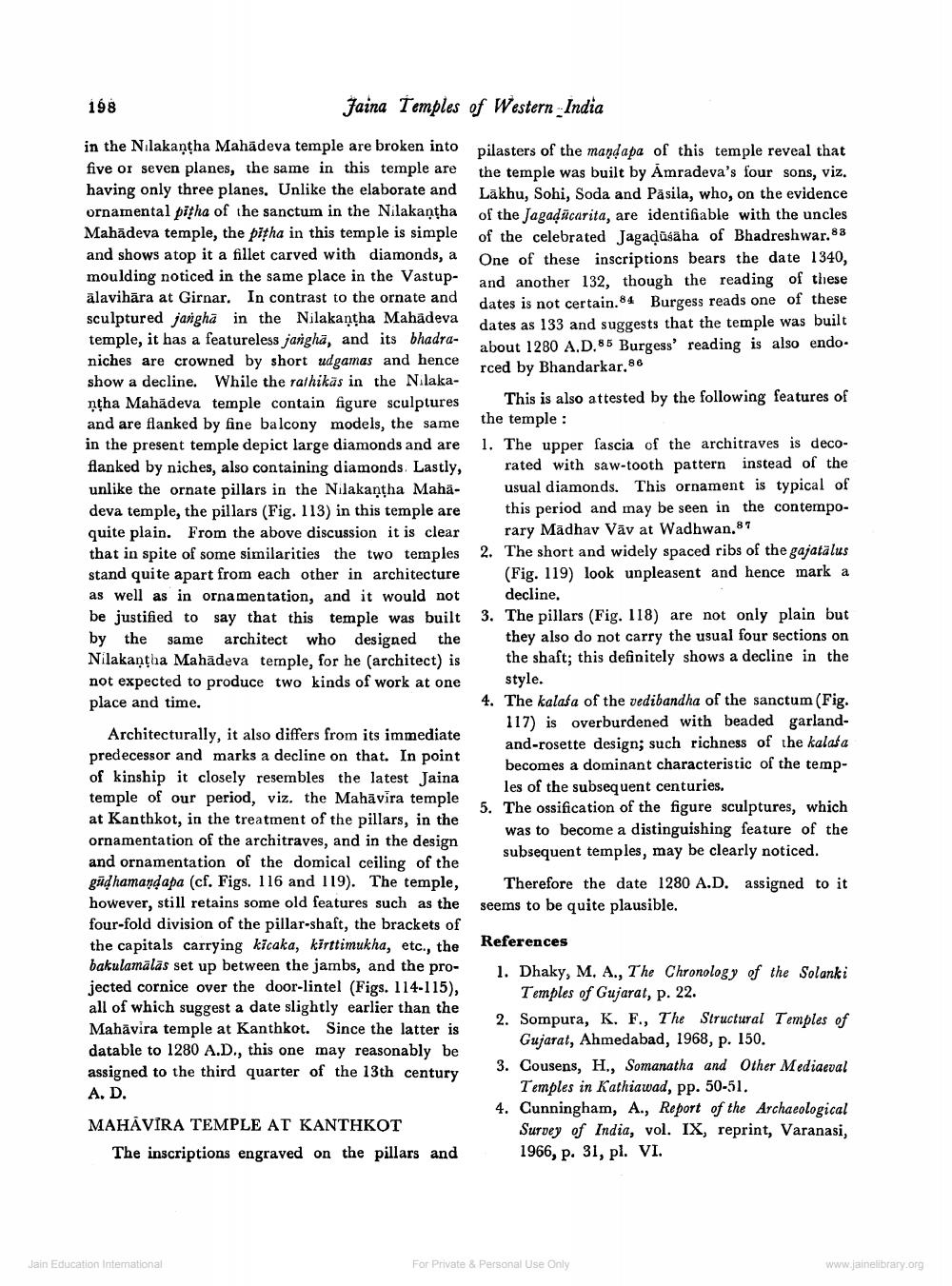________________
198
Faina Temples of Western-India
in the Nilakantha Mahadeva temple are broken into five or seven planes, the same in this temple are having only three planes. Unlike the elaborate and ornamental pitha of the sanctum in the Nilakantha Mahadeva temple, the pitha in this temple is simple and shows atop it a fillet carved with diamonds, a moulding noticed in the same place in the Vastup- alavihāra at Girnar. In contrast to the ornate and sculptured jangha in the Nilakantha Mahadeva temple, it has a featureless jangha, and its bhadraniches are crowned by short udgamas and hence show a decline. While the rathikas in the Nilakantha Mahadeva temple contain figure sculptures and are flanked by fine balcony models, the same in the present temple depict large diamonds and are flanked by niches, also containing diamonds. Lastly, unlike the ornate pillars in the Nilakantha Mahadeva temple, the pillars (Fig. 113) in this temple are quite plain. From the above discussion it is clear that in spite of some similarities the two temples stand quite apart from each other in architecture as well as in ornamentation, and it would not be justified to say that this temple was built by the same architect who designed the Nilakantha Mahadeva temple, for he (architect) is not expected to produce two kinds of work at one place and time.
pilasters of the mand apa of this temple reveal that the temple was built by Amradeva's four sons, viz. Lakhu, Sohi, Soda and Pasila, who, on the evidence of the Jagadücarita, are identifiable with the uncles of the celebrated Jagadūsaha of Bhadreshwar.83 One of these inscriptions bears the date 1340, and another 132, though the reading of these dates is not certain. 84 Burgess reads one of these dates as 133 and suggests that the temple was built about 1280 A.D.85 Burgess' reading is also endo. rced by Bhandarkar.88
This is also attested by the following features of the temple : 1. The upper fascia of the architraves is deco
rated with saw-tooth pattern instead of the usual diamonds. This ornament is typical of this period and may be seen in the contempo
rary Madhav Vāv at Wadhwan.87 2. The short and widely spaced ribs of the gajatalus
(Fig. 119) look unpleasent and hence mark a
decline. 3. The pillars (Fig. 118) are not only plain but
they also do not carry the usual four sections on the shaft; this definitely shows a decline in the
style. 4. The kalafa of the vedibandha of the sanctum (Fig.
117) is overburdened with beaded garlandand-rosette design; such richness of the kalas a becomes a dominant characteristic of the temp
les of the subsequent centuries. 5. The ossification of the figure sculptures, which
was to become a distinguishing feature of the subsequent temples, may be clearly noticed.
Therefore the date 1280 A.D. assigned to it seems to be quite plausible.
Architecturally, it also differs from its immediate predecessor and marks a decline on that. In point of kinship it closely resembles the latest Jaina temple of our period, viz. the Mahāvira temple at Kanthkot, in the treatment of the pillars, in the ornamentation of the architraves, and in the design and ornamentation of the domical ceiling of the gūdhamandapa (cf. Figs. 116 and 119). The temple, however, still retains some old features such as the four-fold division of the pillar-shaft, the brackets of the capitals carrying kicaka, kirttimukha, etc., the bakulamalas set up between the jarbs, and the projected cornice over the door-lintel (Figs. 114-115), all of which suggest a date slightly earlier than the Mahavira temple at Kanthkot. Since the latter is datable to 1280 A.D., this one may reasonably be assigned to the third quarter of the 13th century A. D.
References 1. Dhaky, M, A., The Chronology of the Solanki
Temples of Gujarat, p. 22. 2. Sompura, K. F., The Structural Temples of
Gujarat, Ahmedabad, 1968, p. 150. 3. Cousens, H., Somanatha and Other Mediaeval
Temples in Kathiawad, pp. 50-51. 4. Cunningham, A., Report of the Archaeological
Survey of India, vol. IX, reprint, Varanasi,
MAHAVIRA TEMPLE AT KANTHKOT
The inscriptions engraved on the pillars and
P. 31, pl. vol. IX, repte Archaeological
Jain Education International
For Private & Personal use only
www.jainelibrary.org




